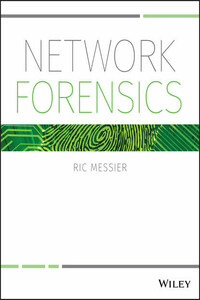One of the best things about the different technology fields, should you have the stomach for it – and many don't – is the near constant change. Over the decades I have been involved in technology-based work, I've either had to or managed to reinvent myself and my career every handful of years or less. The world keeps changing and in order to maintain pace, we have to change too. In one of my incarnations that ended not many months ago now, I ran graduate and undergraduate programs at Champlain College in its online division. One of my responsibilities within that role was overseeing development of course materials. Essentially, either I or someone I hired developed the course and then I hired people who could teach it, often the people who did the development, though not always.
In the process of developing a course on network forensics, I discovered that there wasn't a lot of material around that covered it. At the time, I was able to find a single book but it wasn't one that we could make use of at the college because of policies focused on limiting costs to students. As a result, when I was asked what my next book would be, a book on network forensics that would explore in more detail the ideas I think are really important to anyone who is doing network investigations made the most sense to me.
I like to understand the why and how of things. I find it serves me better. When I understand the why and how, I don't get stuck in a dinosaur graveyard because at its core, technology continues to cycle around a number of central ideas. This has always been true. When you understand what underpins the technology, you'll see it's a variation on something you've seen before, if you stick around long enough. As a result, what is covered in this book is a lot of “how and why” and less of “these are the latest trendy tools” because once you understand the how and why, once you get to what's underneath, the programs can change and you'll still understand what it is you are looking at, rather than expecting the tools to do the work for you.
This is the reason why this book, while offering up some ideas about investigations, is really more about the technologies that network investigations are looking at. If you understand how networks work, you'll know better where to look for the information you need. You'll also be able to navigate changes. While we've moved from coax to twisted pair to optical to wireless, ultimately the protocols have remained the same for decades. As an example, Ethernet was developed in the 1970s and your wireless network connection, whether it's at home or at your favorite coffee shop down the street, still uses Ethernet. We're changing the delivery mechanism without changing what is being delivered. Had you learned how Ethernet worked in the early 1980s, you could look at a frame of Ethernet traffic today and still understand exactly what is happening.
The same is true of so-called cloud computing. In reality, it's just the latest term for outsourcing or even the service bureaus that were big deals in the '70s and '80s. We outsource our computing needs to companies so we don't have to deal with any of the hassle of the equipment and we can focus on the needs of the business. Cloud computing makes life much easier because delivery of these services has settled down to a small handful of well-known protocols. We know how they all work so there is no deciphering necessary.
At the risk of over-generalizing, for many years now there has been a significant emphasis on digital forensics, seen particularly through the lens of any number of TV shows that glorify the work of a forensic investigator and, in the process, get huge chunks of the work and the processes completely wrong. So-called dead-box forensics has been in use for decades now, where the investigator gets a disk or a disk image and culls through all the files, and maybe even the memory image for artifacts. The way people use computers and computing devices is changing. On top of that, as more and more businesses are affected by incidents that have significant financial impact, they have entirely different needs.
The traditional law enforcement approach to forensics is transitioning, I believe, to more of a consulting approach or an incident response at the corporate level. In short, there will continue to be a growing need for people who can perform network investigations as time goes on. With so many attackers in the business of attacking – their attacks, thefts, scams, and so on are how they make their living – the need for skilled investigators is unlikely to lessen any time in the near future. As long as there is money to be made, you can be sure the criminal incidents will continue.
As you read through this book, you will find that the “what's underneath” at the heart of everything. We'll talk about a lot of technologies, protocols, and products, but much of it is with the intention of demonstrating that the more things change, the more they stay the same.








